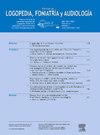作为语言发展的辅助和替代交流
Q3 Nursing
引用次数: 0
摘要
背景和目的一些患有运动障碍、智力障碍、自闭症谱系障碍或严重发育性言语或语言障碍的儿童在发展口语方面有严重困难,有些儿童从未发展出可理解的言语。他们需要辅助和替代交流(AAC),以手语或图形符号的交流辅助形式来补充或替代有限或无法理解的言语,实现最佳的语言发展;对他们来说,AAC的作用是补充或填补语言的功能。本文的目的是讨论作为一种非典型语言发展形式的自适应交际,自适应交际发展的要素和过程,以及通过观察儿童在日常使用中运用的非教策略来学习的重要性。材料和方法对最近的文献进行了研究,并根据作者自己的AAC专业知识进行了反思,以分析将AAC视为一种非典型语言发展形式的艺术现状。词汇,语法,对话,叙述和说明性话语是其中的主题审查。结果研究表明,这些儿童可以学习使用AAC来表达需求、思想、感情等,但与大量关于典型语言发展的科学文献相比,对AAC的研究范围显得狭窄。语言发展的许多核心方面在AAC研究中很少得到解决,这意味着支持AAC语言发展的必要基础部分缺乏。本文章由计算机程序翻译,如有差异,请以英文原文为准。
Augmentative and alternative communication as language development
Background and aims
Some children with motor impairments, intellectual disabilities, autism spectrum disorder or severe developmental speech or language disorder have severe difficulties in developing spoken language and some never develop intelligible speech. They need augmentative and alternative communication (AAC) in the form of manual signs or communication aids with graphic symbols to supplement or substitute for limited or no intelligible speech and achieve an optimal language development; for them the role of AAC is to complement or fill the functions of speech. The aim of this paper is to discuss AAC as an atypical form of language development, the elements and processes involved in development of AAC, and the importance of learning from observing the untaught strategies children apply in everyday use of AAC.
Materials and methods
Recent literature was examined and reflections based on the author's own AAC expertise were made to analyze the state of the art regarding AAC as an atypical form of language development. Vocabulary, grammar, conversation, narratives, and expository discourse are among the topics reviewed.
Results
Studies have demonstrated that these children can learn to use AAC to express needs, thoughts, feelings and so forth, but compared to the large scientific literature on typical language development, research on AAC appears narrow in scope.
Conclusions
Many core aspects of language development are rarely addressed in AAC research, implying that essential parts of the foundation for supporting language development with AAC are lacking.
求助全文
通过发布文献求助,成功后即可免费获取论文全文。
去求助
来源期刊

Revista de Logopedia, Foniatria y Audiologia
Nursing-LPN and LVN
CiteScore
1.10
自引率
0.00%
发文量
28
 求助内容:
求助内容: 应助结果提醒方式:
应助结果提醒方式:


